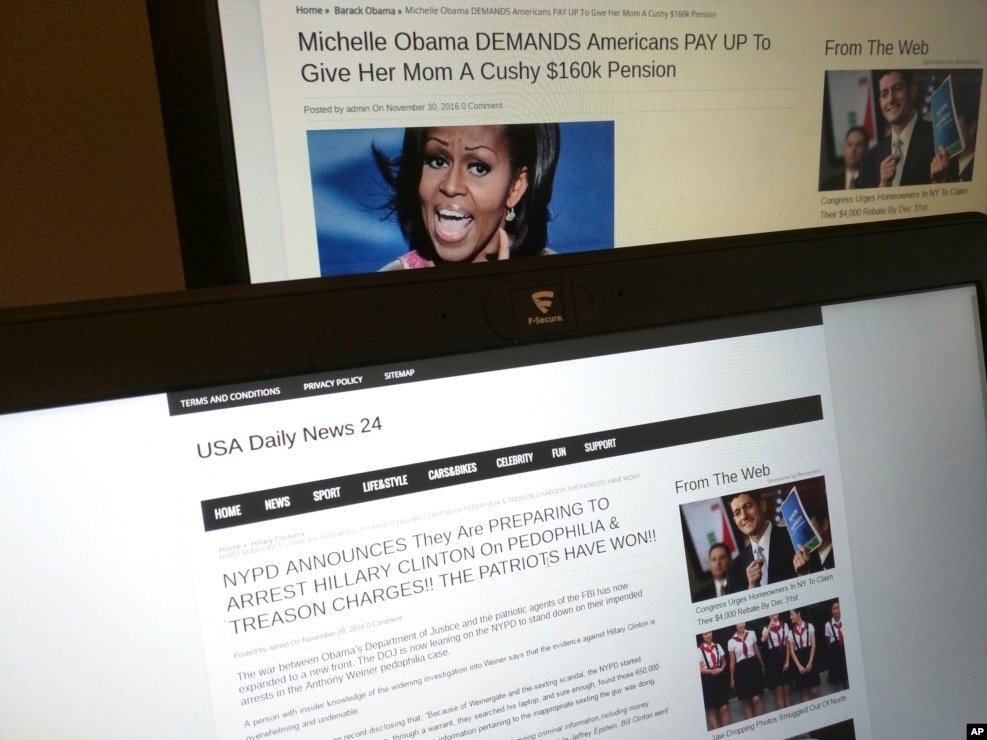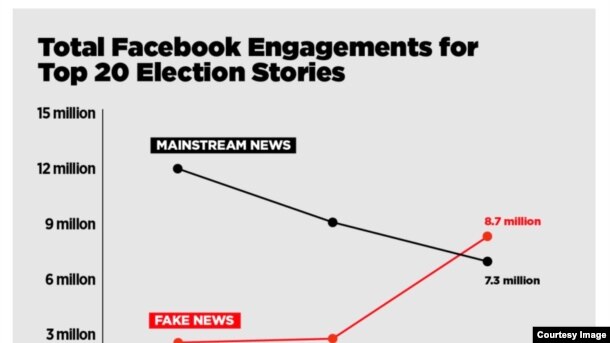
In the past, most people received their news from newspapers, magazines and broadcasters. But now, just about anyone can report and publish on the Internet and share it as news through social media.
The problem: not all of the information is true and not all of the reporting is trustworthy.
After the presidential election last November, many people even questioned whether “fake news” had influenced the election results.
This has led Facebook to work with organizations to find out whether a disputed story is true or false and educators to train students to become responsible readers of news
What really is "fake news?"
The term “fake news” is complicated, because it is not always clear what that means. People have used the term to identify everything from news stories reporting false facts, to stories reporting facts they disagree with.
Howard Schneider, a former editor of the newspapers Newsday, started the Center for News Literacy at Stony Book University in 2007. The center has multiple projects, but the most visible is a course to teach News Literacy.
The course trains students to look for various details that may indicate the validity of the story. Does the body of the story actually relate to the headline? Are there a lot of overstated or extreme sentences? Are there facts in the story and can they be proven? Is it written by a well-known journalist?
Richard Hornik is the Director of Overseas Partnership Programs for the Center for News Literacy. He says the problem of fake news really has two parts: stories with actual false information, and poor journalism in general.
“It's not about spotting a bogus (or false) piece, it's also about spotting a piece that could have been better… to quote Daniel Patrick Moynihan, a former senator from New York, 'everyone is entitled to their own opinions but not entitled to their own facts.'”
In some ways, Hornik says that Schneider anticipated the fake news crisis. He says, “His [Schneider's] insight was that there is no point in training quality journalists if the public didn't really know the difference between journalism and something else…”
Spreading the news
The University of Michigan, or UM, has a similar course to train students to research the validity of news stories, and to be aware of biases.
Doreen Bradley is the university's Director of Learning Programs and Initiatives. She says, “What is really an important step for people is realizing they don't come with an unbiased view, that they have a certain viewpoint.”
She gives this advice to students: “take yourself out of your own current view and to appreciate someone else's…we think is really critical for dialogue.”
Another problem, Bradley says, is the fact that most students are using Facebook and Twitter to get their news, rather than going to more traditional news websites or publications.
Students are too busy
Michelle Sheng is a third-year student at the University of Michigan. Sheng finds that students either just stop reading the news or only take news from one source that they trust.
“A lot of people are jaded about the news. People are too busy to keep up with the news, and it is really easy to take whatever news is given to you because you don't have the time to figure it out yourself,” she says.
For her part, Sheng recently created a digital exhibit for the university library of images to educate students on steps they can take to better analyze the news.
Educating the public
Richard Hornik feels it is important to educate an even larger audience, beyond American university students.
Hornik and the Center for News Literacy have developed teaching resources, as well as a free online news literacy course on Coursera. The news literacy courses have been taught at universities in Vietnam, Malaysia, Myanmar, Australia, Russia, Hong Kong, and Poland.
They are also trying to reach a younger audience. They have partnered with several secondary schools in the American state of New York to teach news literacy.
One school is the Intermediate School, or IS, 303 in Brooklyn borough of New York City. The school uses various activities, like having students determine whether videos on YouTube were real or fake, or if websites are independently confirming their stories before printing them.
According to the New York Times, IS 303 teacher Rema Kaddah tells her students to be selective about what they take and accept as truth, and to not accept somebody else's truth. They need to be ready to “fact check this world.”
Middle school is not too early to start, it seems. As Stony Brook university student Paula Pecorella says, news literacy should begin “by the time you start interacting on the web, whether it's social media or any other kind of forum.”

Changing human behaviors
Doreen Bradley of the University of Michigan says people should research and confirm what they read online. However, she says, “to change human behavior is a difficult thing… but that really is the only thing that is going to help.”
Hornik agrees as well. “The biggest problem is not getting people to be able to recognize bad journalism or fake news, the biggest problem is getting people to want to recognize it. Our brains are wired to seek out information that agrees with our current beliefs.”
I'm Phil Dierking
This story was written for VOA Learning English by Phil Dierking. Hai Do was the editor.
What do you think the best way is to teach people about fake news and poor journalism? How can someone spot it? We want to hear from you. Write to us in the Comments Section or on our Facebook page.
Words in This Story
anticipate - v. to think of something that will or might happen in the future
algorithms - n. a set of steps that are followed in order to solve a mathematical problem or to complete a computer process
bias - n. a tendency to believe that some people, ideas, etc., are better than others that usually results in treating some people unfairly
bogus - adj. not real or genuine
dialogue - n. a discussion or series of discussions that two groups or countries have in order to end a disagreement
digital exhibit - n. an electronic work of art, designed to demonstrate a concept, that his housed in a cultural or educational setting.
headline - n. the title written in large letters over a story in a newspaper
literacy - n. the ability to read and write
jaded - adj. feeling or showing a lack of interest and excitement caused by having done or experienced too much of something
validity - n. the quality of being real or correct

